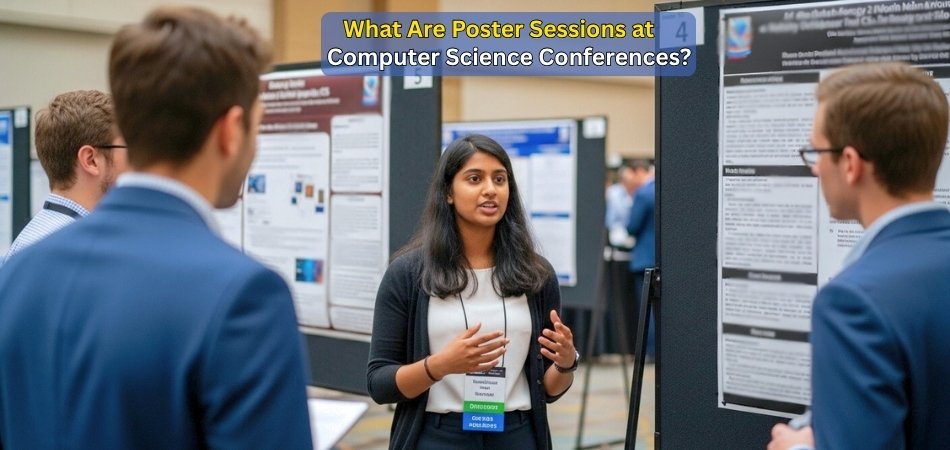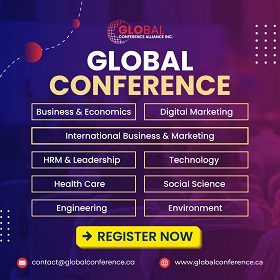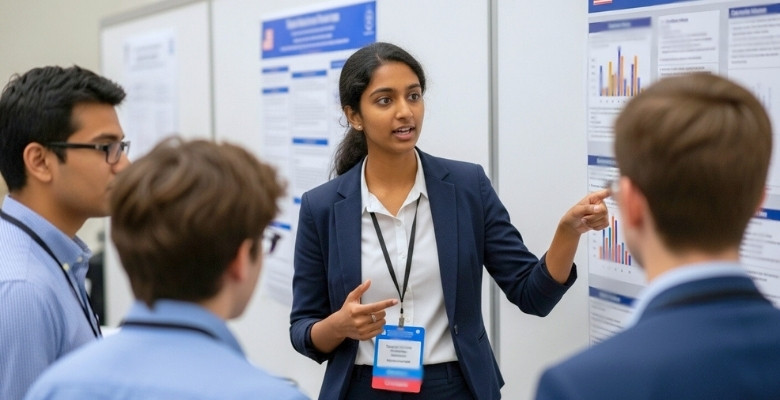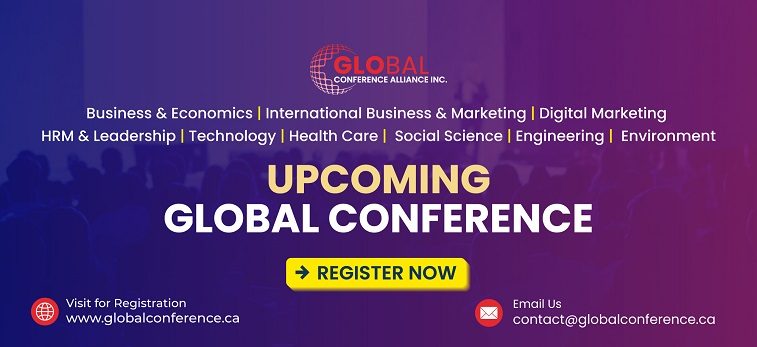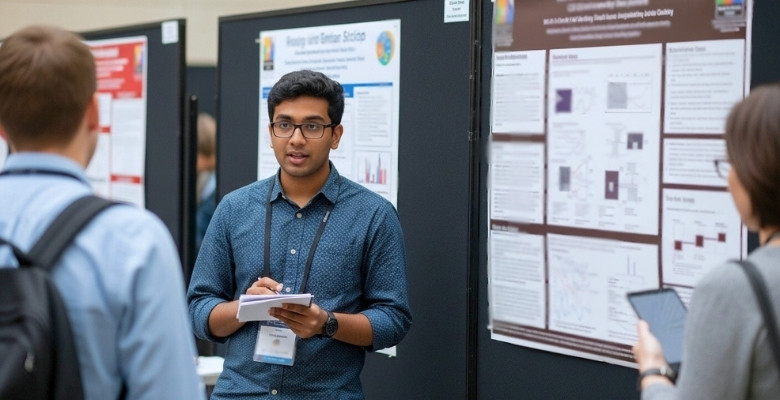Computer science conferences are full of new ideas, exciting research, and interesting people. These events bring together smart minds to share their work in different ways. Some people give talks on stage, while others prefer more relaxed formats. You might be wondering what are poster sessions at computer science conferences?
Poster sessions at computer science conferences are informal displays where researchers share work using posters. Visitors walk around, ask questions, and have friendly talks. These sessions include charts, demos, and open conversations, making research easier to understand and more interactive.
If you’re curious about how poster sessions work or how they’re different from talks, this article has all the answers. You’ll learn what they are, how they help, and even how to design your own. Keep reading to explore everything in simple and clear steps.
What Are Poster Sessions at Computer Science Conferences?
Computer science events often include a science fair-like section rather than a formal lecture. It’s called a poster session, and it brings research to life in a very interactive way. Let’s explore what makes it so interesting.
Poster Display
A poster session is a space where researchers show their work using large printed posters. These posters include the project title, names of the people involved, a short background, steps taken, and the results. Charts, pictures, and short notes help explain things clearly. The posters are pinned on boards in a big hall so people can walk around, read, and ask questions if they want.
Presentation Time
Each presenter has a time slot to stand near their poster. Instead of giving a long speech, they talk directly to people who stop by. This setup makes it more personal. Visitors can look around at different posters and choose what interests them most. It’s less formal and gives everyone a chance to connect more easily with the research being shown.
Personal Interaction
During a poster session, anyone can stop by a poster, start a conversation, and ask questions. There’s no big stage or microphone—just people talking. The presenter explains the work, and the visitor learns more without needing to sit through a long talk. These moments often turn into simple, helpful discussions about the topic.
Poster Design
The way a poster looks really matters. A clear, colorful poster with big titles, neat charts, and simple language gets noticed fast. If it’s too crowded or messy, people might pass it by. Good posters are easy to read and easy to follow. Presenters usually work hard to make sure their posters are both eye-catching and clear.
Open Setup
Poster sessions are held in large open spaces where people can move around freely. There’s no set path to follow, so visitors can walk anywhere, stop where they like, and spend as much or as little time as they want. This open style makes it more relaxed and helps people learn in a way that feels natural.
Live Demos
Sometimes, presenters bring a laptop or tablet to show a short demo, animation, or video. This helps explain their work in a more exciting way. Seeing something in action makes it easier to understand. And if you’re planning for global events like upcoming conferences in USA, Canada, or any other country, you’ll find these live add-ons are often part of the poster session experience.
Friendly Conversations
Poster sessions give people a chance to have honest, face-to-face talks about new ideas. Presenters can change how they explain things depending on who’s asking, so everyone feels included. These simple chats can be one of the best ways to really understand a project, no matter how complex it is.
Poster sessions are one of the most engaging parts of computer science events. They turn research into something visual, simple, and easy to talk about. With no pressure and plenty of open conversations, learning feels natural. If you ever get the chance, don’t miss walking through one.
How Poster Sessions Differ from Oral Presentations at CS Conferences?
Poster sessions and oral presentations are the most common formats for presenting research in computer science conferences. Each serves a different purpose and offers unique opportunities for sharing and discussing research. The table below outlines their key differences.
| Aspect | Poster Session | Oral Presentation |
| Format | Static visual display (poster) with informal discussion | Formal slide-based talk presented to an audience |
| Time Limits | No strict time limit per attendee; session lasts 1–2 hours | Strict time limit (typically 10–30 minutes per talk) |
| Audience Interaction | High interaction; attendees ask questions one-on-one or in small groups | Limited to Q&A at the end of the talk; the audience listens passively during the presentation |
| Setting | Open space or hall; multiple posters presented simultaneously | Dedicated room with sequential talks, one speaker at a time |
| Review Criteria | Often less selective; may focus on work-in-progress or early-stage research | More selective, typically for mature, peer-reviewed research |
| Purpose | Encourage feedback, networking, and exposure for early ideas | Disseminate completed research findings to a wider audience |
| Preparation Effort | Requires designing and printing a poster; less formal rehearsing | Requires slide preparation and practice for timed delivery |
| Visibility | Lower individual visibility due to simultaneous posters | Higher visibility; the entire audience focused on one presenter |
Understanding these differences helps researchers choose the right format for their work and prepare accordingly. While poster sessions foster informal, interactive feedback, oral presentations offer greater visibility and a structured platform for presenting mature research findings.
Benefits of Presenting a Poster at a Computer Science Conference
Posters can be a fun and simple way to share your ideas. They don’t need slides or speeches, just a good design and clear talk. Many people find poster sessions less scary than giving a full talk. Keep reading to see why posters can be a great choice at conferences.
Easy to Explain Ideas
You get more time to explain your project without feeling rushed or stressed. People can ask questions while looking at your poster up close. You don’t need to use fancy words or fast slides. Everything is slow and simple, which helps both you and the listener. You can point to different parts and answer in your own words. This makes it easier to talk clearly and stay calm the whole time.
Get Helpful Feedback
Many visitors will share thoughts or ideas after reading your poster. They might see things in your project that you didn’t think about before. These small comments can help you fix or improve your work. It feels more like a normal chat than a school test. You’ll learn faster when people give real feedback in a kind way. This helps you understand your project better and grow new ideas as well.
Make New Connections
Sometimes a small chat at a poster leads to something much bigger. A quick hello can turn into a new friendship or project later on. You don’t have to search for people—they come right to your space. Everyone is open to talk, so it’s easy to connect. You may even find someone with the same interests as you. These simple meetings can give you chances to work with others in the future.
Show Early Work
When your project is not finished yet, a poster is still okay. You can still show what you have and hear what others think. Posters are great for sharing ideas that are still being built. In large academic events—such as those held in the USA—oral presentations often come from full-length peer-reviewed papers. If you’re aiming for that format, you’ll need to submit a paper to a computer science conference in the USA, which typically involves a more competitive review process compared to poster sessions.
Learn from Others
Every poster session is also a chance to see other great ideas. You can walk around and ask other people about their work. This helps you learn new things while also sharing your own project. It’s much easier to ask questions at posters than during talks. Everyone is relaxed and open to explaining things step by step. You learn without pressure, just by talking and listening to different people.
Posters are a good way to share ideas without much stress. You can meet new people and learn from what others are doing. Even early projects can get attention and helpful advice from others. If you enjoy talking in small groups, poster sessions are perfect.
Design Tips for Creating an Effective Research Poster for Computer Science Conferences
Making a poster for a computer science conference isn’t just about writing facts on a big sheet. It’s also about how everything looks and feels to the person reading it. A well-designed poster can grab attention and explain your work clearly. Want to make yours stand out in a crowd? Let’s go over some simple but smart design tips.
- Layout Structure: Make sure everything is placed in neat sections like title, intro, methods, and results so people can follow your poster easily.
- Font Sizes: Use big, bold letters for the title and a larger font for headings. Keep the body text easy to read from a short distance.
- Color Schemes: Pick a few colors that look good together. Don’t go too bright or too dark, and make sure the text stands out.
- Clear Graphics: Add clean charts, graphs, and diagrams that explain your work. Avoid messy or unclear images that may confuse people.
- Simple Fonts: Choose fonts that are easy on the eyes, like Arial or Calibri. Fancy or curly fonts can be hard to read quickly.
- Space and Balance: Leave enough empty space between sections. A crowded poster can look messy and make it hard for people to focus.
- QR Codes: Add a QR code that links to extra info like a video, full paper, or website so others can explore more if they want.
Designing a poster isn’t just about style—it’s about helping others understand your work quickly and clearly. When done right, even complex topics become easy to follow. A clean and smart poster shows that you care about your work. Put in the effort, and your poster will get noticed.
Common Mistakes to Avoid When Presenting a Poster at Computer Science Conferences
Designing a poster is only half the work—you also need to present it well. Sometimes, small mistakes can make it hard for others to understand your work. Posters should be clear, neat, and easy to follow. Let’s explore what to avoid so your poster stands out for the right reasons.
Too Much Information
Posters with too many words or pictures are hard to read. Messy or crowded layouts may discourage people from stopping. Keeping it simple helps others focus on your main points quickly. You want your poster to speak clearly, even from a few steps away. A clean design shows you understand your topic and helps others understand it too, without feeling lost or confused.
Tiny Text Sizes
Some posters use very small writing that can only be read up close. This makes it hard for people to stay interested, especially in a busy room. Big, bold text is much easier for everyone to see and read. Use large titles and normal-sized text for the details. When your poster is easy on the eyes, more people will stop to read. The clearer your words, the better your message will come across.
Reading Word-for-Word
It’s okay to glance at your poster, but reading it line by line is not helpful. People want to hear you explain things in your own words, not repeat the text. This also makes the talk more fun and easier to follow. At large academic events—such as those held in the USA—poster sessions often attract a diverse, curious audience. To engage effectively and get the most out of a computer science conference in the USA, it’s important to avoid common mistakes like overloading your visuals or reading straight from the poster.
Ignoring Visitors Nearby
If someone walks up to your poster and you stay silent, it feels unfriendly. A simple hello or smile can make others feel welcome to ask questions. Even if you’re shy, try to make eye contact or nod when someone is looking. This shows you care about your work and are open to sharing. Being friendly helps people stay longer and talk more about your project without feeling awkward.
Poor Poster Structure
Your poster will be difficult to follow if you don’t place things neatly. People don’t want to guess where to start or which section comes next. Use boxes, arrows, or numbers to guide the reader through your story. Keep your title big and your sections in order from top to bottom. A good structure lets others understand your work quickly and enjoy reading what you’ve shared.
Small mistakes can make a big difference when showing your poster. You don’t need to be perfect, just clear and welcoming. The goal is to help others enjoy and understand your work. When done right, your poster can leave a strong and happy impression.
Commonly Asked Questions
Poster sessions are fun, open, and full of learning moments—but if you’re new to them, you might still have questions. Whether you’re planning to attend or thinking of presenting, these FAQs can help clear up the basics. Here are some common questions people often ask before joining a poster session. Read on to learn more in a simple and easy way.
Who Can Present a Poster?
Anyone who has done research or a project can present a poster. You don’t have to be a professional or have a long paper published. Some people show small or early ideas that they’re still working on. If your project fits the event, you can usually apply to present it.
How Are Posters Selected?
Posters are usually chosen after you send a short summary of your project. A small group checks if the topic fits the conference theme. They don’t expect perfect work—interesting ideas and clear goals are often enough. If it gets accepted, you’ll be invited to bring your poster to the event.
Do I Need Special Tools to Make a Poster?
You don’t need any fancy tools to make a good poster. Most people use simple programs like PowerPoint or Google Slides. These let you add text, charts, and pictures in a clean layout. What matters most is keeping everything neat and easy to read.
How Big Should a Poster Be?
Posters are usually large enough to be seen from a few feet away. The most common size is around 36 x 48 inches, but this can change based on the conference. Always check the rules before printing. A bigger poster helps people see your work without standing too close.
What Should I Wear at a Poster Session?
You don’t have to wear anything too fancy or formal. Just wear something clean and comfortable that looks nice. A neat outfit helps you look ready and confident. The main focus is your poster and how you explain it, not your clothes.
Can I Use Videos or Animations?
Yes, many people bring laptops or tablets to show short videos or demos. It helps others understand your work better, especially if it’s a tech-based project. Just make sure the sound isn’t too loud. Keep your video short and clear so it doesn’t take too long to explain.
Is It Okay to Be Nervous?
It’s completely normal to feel nervous before you talk to people. But remember, poster sessions are more like conversations than speeches. Most people are friendly and curious about your work. Just speak slowly, smile, and answer questions as best as you can.
What If No One Stops at My Poster?
Sometimes people walk by without stopping, and that’s okay. Don’t feel bad—it doesn’t mean your work isn’t good. Try standing near the walkway and making eye contact or smiling. A friendly face can make someone curious enough to stop and talk.
Can I Take Breaks During the Session?
Yes, you can take short breaks, but try to stay near your poster most of the time. If you need to leave for a few minutes, ask a friend or teammate to cover for you. It’s best to be there so you don’t miss someone interested in your project. Being present shows that you care about your work.
Bottom Line
A poster session gives you a chance to talk with others about your computer science research without standing on a stage. It becomes easier to understand and enjoy research when posters are colorful, simple, and clear. The casual setting makes it easy for you to have real conversations, get feedback, and learn something new.
If you’re wondering what are poster sessions at computer science conferences? They are events where researchers display large posters with their work and discuss it directly with visitors. This setup allows personal interaction, makes complex topics easier to explain, and helps create meaningful connections. Poster sessions are more visual and informal than traditional talks, giving everyone a chance to ask questions and share ideas in a calm, easygoing space.
You should use large, readable fonts, keep your design clean, and welcome visitors with a smile during a poster session. You should avoid tiny text, overcrowded layouts, and reading straight from the board. Instead, explain things naturally and be open to questions. Best of luck at your next conference—your poster can make a big impact!

